I have always liked horses, even though I wouldn’t consider myself a horse person: a feat which in modern times requires not just a great love for these majestic beasts, but an equally large wallet for their feed and care. Personally, I prefer dogs for their relative low maintenance and portability, but I am always happy to make friends with horse owners, just so I can hang out with my equine buddies. My first real experience with a horse was as a young man at the age of 19, when I had been hired as an actor to play the lead in a half-hour CBC family special, called “One Boy, One Wolf, One Summer”, co-starring a character actor named Michael Ironside. The show was just about as sappy and awful as the title suggests, but it was one of my first gigs as a young actor, and decked out in cowboy gear, I was meant to look like I could actually ride a horse and shoot a gun. I was taught to ride horses by Danny Virtue, a long time industry insider; not just to how to ride a horse, but also how to appreciate their body language as a communication tool. The location for the film shoot was close to a place called Merritt, in the rugged grasslands and ponderosa of interior of British Columbia. I was given a horse named Snowy, a gentle fellow – no doubt suitable for a newbie like me. When I rode him, I remember how he would cock his ears in a very particular way, to let me know that I was riding him correctly. Despite their massive size and power, horses are exquisitely sensitive and nervous creatures, and have a lot to teach us about listening to our own bodies.
Since my acting days, I have had a few occasions to work with horses as a herbalist. About 15 years ago I was hired to develop a line of products for race horses, to help with the many side-effects that come from the stress and abuse of this industry, including lung and joint problems. But after some time I stopped work on these products, wary of supporting an industry that is essentially nothing more than a form of animal abuse. Recently I was asked to help another horse named King, that had a chronic abscess in his groin for well over a year, and had been treated by veterinarians with multiple rounds of antibiotics, both externally and internally, to no effect. When I first met him, King was a little trepidatious, particularly when it came to me examining the abscess in his groin. He stamped his feet a little, and tried to move away from me. No doubt he had grown weary of all the people that had come to look at his crotch, apparently without benefit. I wonder how would you feel? But I made sure to connect with him, and let him know that I was here to help, that I would do my best, as I discussed the treatment plan with his owner.
Here is what the abscess looked like when I first saw it (enlarged blurry iPhone photo):
 An abscess is a pocket of infection fill with pus, often caused by Staphylococcus or Streptococcus, that lies hidden below the overlying skin. The tricky thing when treating an abscess is being able to access the infection, without causing too much trauma to the overlying tissues, which creates more opportunity for infection. While very large abscesses can be drained by lancing them, this infection was a collection of several follicles of pus that couldn’t be drained so easily, all caused by previously lancing the abscess but not properly controlling the infection.
An abscess is a pocket of infection fill with pus, often caused by Staphylococcus or Streptococcus, that lies hidden below the overlying skin. The tricky thing when treating an abscess is being able to access the infection, without causing too much trauma to the overlying tissues, which creates more opportunity for infection. While very large abscesses can be drained by lancing them, this infection was a collection of several follicles of pus that couldn’t be drained so easily, all caused by previously lancing the abscess but not properly controlling the infection.
After the area was to be washed with gentle soap and water, I suggested a potato-based poultice be applied more or less continuously to the area over a three day period. This is an old folk remedy, based on the potato’s ability to draw out infection, and I also included raw onion and garlic, as well as salt, as additional drawing agents. The concept of “drawing-out” an infection is as old as the hills: all herbal traditions know and speak of it, but as a concept it is uniformly absent from modern medical and veterinary practices. Go figure. Anyway, to this formula I added the antimicrobial herb turmeric, and some egg white to help hold the poultice together:
• 1.5 cups raw grated potato
• 0.5 cups raw grated onion and garlic
• 1 tbsp turmeric
• 1 tsp salt
• one egg white
These ingredients were mixed well and smeared into the crease of groin, overlying the entire area and beyond, and King’s owners came up with a bandaging system to hold the poultice in place. The poultice was removed when it dried, and the area was gently rinse area with water, and the poultice reapplied. The goal was 2-3 applications per 24 hours. As I expected, within 3 days the abscess ripened and burst:
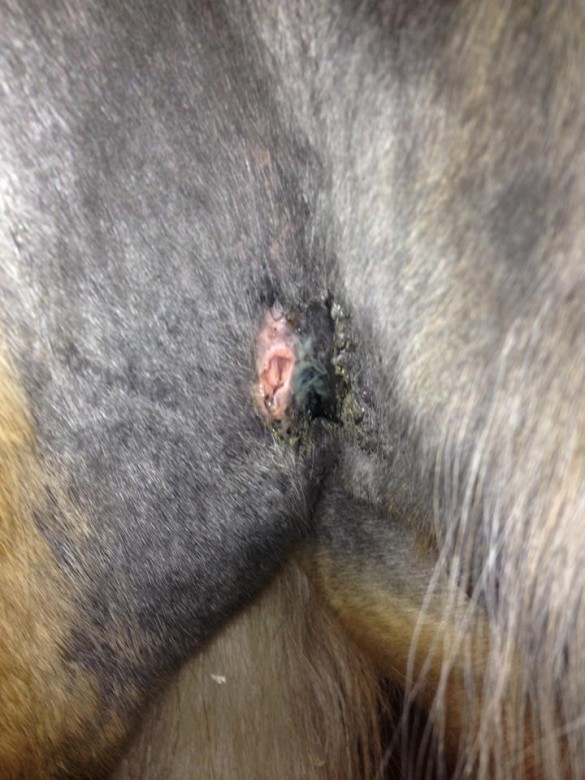 At this stage, Staph infections tend to heal over rapidly, and if this occurs, the little pockets of infection will evade resolution and persist. This is pretty much what had been happening for the last year or so. For this next stage, we applied the combined tinctures of goldenseal, echinacea, agrimony, plantain and calendula, which was syringed into the abscess to wash out the infection. Tincture of iodine was also applied periodically. Following this, the abscess was packed with activated charcoal, which is a powerful agent to adsorb wastes and toxins, essentially, drying out the abscess cavity to prevent further infection. Sometimes we forget in our battle against bacteria, that we don’t need to rely on powerful antibiotics to kill them, speeding up the process by which they become resistant to these compounds. For life to exist, water is a necessary component, especially so for bacteria the live on our skin and bodies. Thus, by using agents like activated charcoal, or astringent remedies such as the Ayurvedic medicine called sphutika (purified alum), we can effectively kill bacteria in a general way without using specific antibiotic compounds. Simple and elegant.
At this stage, Staph infections tend to heal over rapidly, and if this occurs, the little pockets of infection will evade resolution and persist. This is pretty much what had been happening for the last year or so. For this next stage, we applied the combined tinctures of goldenseal, echinacea, agrimony, plantain and calendula, which was syringed into the abscess to wash out the infection. Tincture of iodine was also applied periodically. Following this, the abscess was packed with activated charcoal, which is a powerful agent to adsorb wastes and toxins, essentially, drying out the abscess cavity to prevent further infection. Sometimes we forget in our battle against bacteria, that we don’t need to rely on powerful antibiotics to kill them, speeding up the process by which they become resistant to these compounds. For life to exist, water is a necessary component, especially so for bacteria the live on our skin and bodies. Thus, by using agents like activated charcoal, or astringent remedies such as the Ayurvedic medicine called sphutika (purified alum), we can effectively kill bacteria in a general way without using specific antibiotic compounds. Simple and elegant.
On my second visit, after the abscess had burst, King was a little more patient with me, and I could sense in his body language that he trusted me a little more. He stood still while I examined his groin, and let stroke his neck and scrub his muzzle. With the abscess now drained, I suggested an internal formula of herbal powders, to be mixed with water and a little molasses, and administered orally with a syringe. This formula was comprised of notoginseng (sanqi), echinacea, mullein, cleavers, turmeric, licorice and fennel, given twice daily for two weeks. The first of these herbs, notoginseng, is a major component of the famous Chinese herbal formula Yunnan Bai Yao, used extensively with any kind of bleeding, trauma, broken bones, and damaged tissues. San qi is a member of the Araliaceae, like ginseng, and shares some similar properties. It is unique for being a herb that stops bleeding but also promotes proper circulation. When I practiced in Trinidad and Tobago in 2005, I had one patient come to me with retinal hemorrhage (internal bleeding within the eyes), as a complication of uncontrolled diabetes. A dramatic reduction in dietary carbs and this herb not only saved his sight, but made a significant impact in controlling his blood sugar. For my horse patient, I added the sanqi to ensure the proper circulation of blood, which is a key element in wound-healing and regeneration. In addition to the herbs, I suggested that King’s diet of hay be supplemented with some sauerkraut to rebuild his microbiome, to be mixed with a little apple for palatability, on a daily basis.
At first the lesions seem to be healing up well, but then it seemed that another little pocket of infection was forming again. This is typical with long-standing infections, so again the poultice was applied to pull it out, and the same procedure was used. Sometimes the process of healing is two steps forward, and one step back. In total, it took about three weeks of continuous treatment to resolve the infection completely.
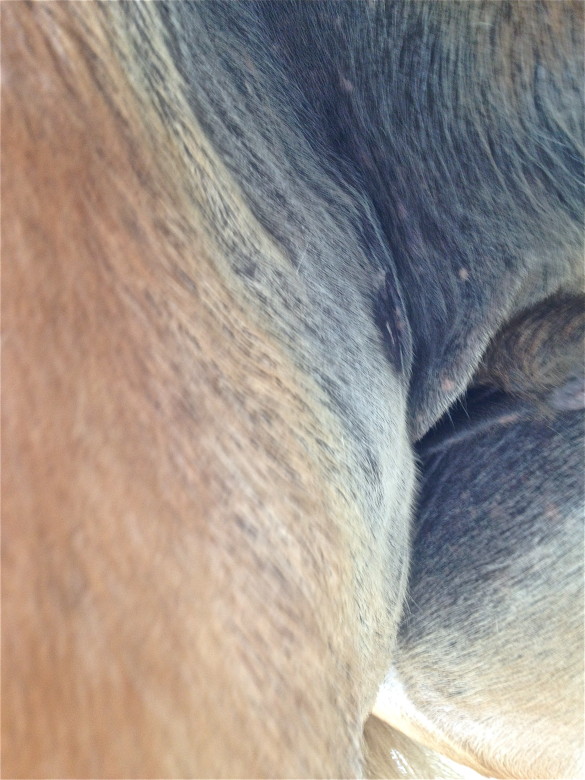 On my last visit, I could tell that King was happy to see me. The lesion had healed up well, and free of the chronic discomfort that had plagued him for the last year, King was in a good mood. He patiently let me examine the lesion, and then afterwards let me give him some love. I gave King’s owner a jar of my comfrey/calendula/plantain salve, and had them apply it over the well-healed lesion. Note, however, that I didn’t use this salve at the beginning. This is because using a salve with an infection essentially helps to seal it in. Remember that for an infection, we want to make it as inhospitable as possible, which is why drying agents such as activated charcoal, alum, or triphala powder work so well. Think of the difference between the Sahara desert, where life hardly exists, versus that of a moist tropical jungle which is teeming with life. Applying oil immediately creates a “biodome” for rapidly multiplying bacteria. Comfrey in particular is such a powerful wound healer that when applied topically, if the infection isn’t resolved, it will heal the upper layers of the skin and cause another abscess to form below. Thus wound-healing salves such as this are best used after any potential infection has been resolved, to promote deeper tissue healing and prevent scar formation.
On my last visit, I could tell that King was happy to see me. The lesion had healed up well, and free of the chronic discomfort that had plagued him for the last year, King was in a good mood. He patiently let me examine the lesion, and then afterwards let me give him some love. I gave King’s owner a jar of my comfrey/calendula/plantain salve, and had them apply it over the well-healed lesion. Note, however, that I didn’t use this salve at the beginning. This is because using a salve with an infection essentially helps to seal it in. Remember that for an infection, we want to make it as inhospitable as possible, which is why drying agents such as activated charcoal, alum, or triphala powder work so well. Think of the difference between the Sahara desert, where life hardly exists, versus that of a moist tropical jungle which is teeming with life. Applying oil immediately creates a “biodome” for rapidly multiplying bacteria. Comfrey in particular is such a powerful wound healer that when applied topically, if the infection isn’t resolved, it will heal the upper layers of the skin and cause another abscess to form below. Thus wound-healing salves such as this are best used after any potential infection has been resolved, to promote deeper tissue healing and prevent scar formation.
Just before I left, the stablehand took a photo of King, me and his owner. I had just finished examining him, and although it probably helped that I tasted nice and salty, I think his body language is pretty clear. Horse medicine is good medicine.
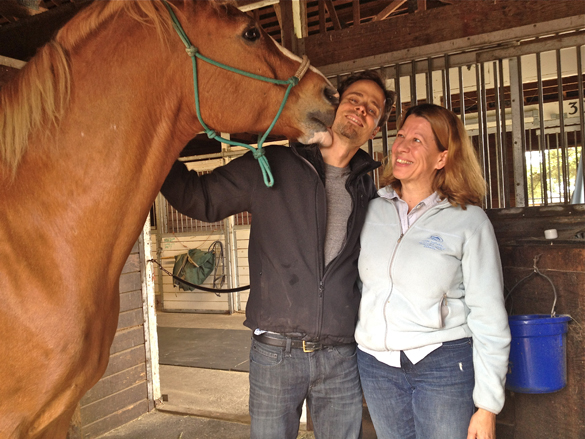
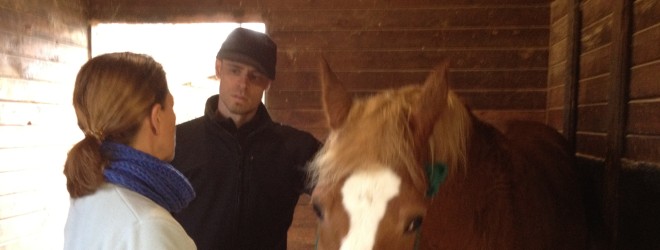

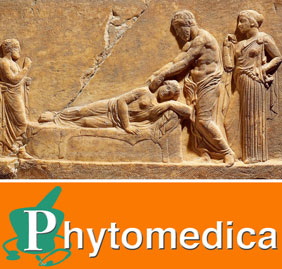
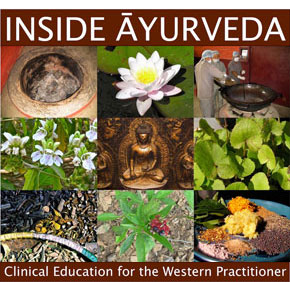



What a Wonderful article.~! to me this was especially interesting because 2 years go i had a carbuncle on my right chest and it was drainining from five places. very acrid and burning. it lasted about two or three weeks. it formed its own draining channels . at first there was this white cheeseylookin stuff that was coming out then later a clear yellowish liquid sometimes mixed with blood, the clear yellow stuff was excruciatingly acrid. towards the end of the infection after it had done considerable draining of both types, i got some salve from the pharmacy some triple-antibiotiotic ointment. i only used it two or three times tho cuz i noticed it was closing up the holes thru which the absess had been draining and there was still stuff left innit that needed to drain. so since that ointment sealed it over before it ws thoroughly drained i’m left with this partially healed absess that has a lump under it and the scars that healed on the surface left sorta triangular shaped shallow holes leaving the wounded area looking like a ‘bearclaw’ print on my chest. there is still some slight pinkness to the area but no pain, and recently i bumped my chest on the refrigerator door and the next morning i noticed that some stuff had drained from those bearclaw holes. like my body knows what’s goin on and build a temporary spot on the skin where when it needs to it can shuttle the gunk out those holes by opening them up again as when i bumped it on the fridge door, which kinda hurt. anyway i still have the lump under it and it looks kinda ugly. sometimes i’m tempted to pick at it or do some squeezing but there is a hard packet uderneath it and the outer surface has healed it closed. i was hoping i could dissolve it from the inside. any ideas ? i don’t believe in antibiotics so didnt take the ones prescribed~but DID use the topical salve towards the end of its draining to protect it from more infection. actually i just wanted the salve to ease the burning sensation from whatever acrid substance made the drain holes and burned as it was draining. the inflammation and burning was so bad that it woke me up at night. anyway~! Wonderful job on King~! You know he’s gotta love ya for that~! anything i can do to clear up this lump under that old carbuncle ? i’ve had it for 2 years. since May of 2012.
at one point when it started i used herbal tea compress. burdock Jatoba’ Pau D arco~made a decoction and soaked cotton innit then taped that on there. and i was taking biochemic cellsalts Silica and calcsulf (CalciumSulfate), then kalisulph (PotassiumSulfate) and kalimur (PotassiumChloride) . it sure is hard to doctor yerself when yer all inflammed and in pain and cant concentrate, not to mention not really knowin what yer doin. felt like i was in hell for about two weeks.
anyway, thankyou for this aticle Todd. i learned from it and liked it alot~! i am POSITIVE King is a very HappyCamper~!
I think you could definitely apply the techniques described in the blog. Be careful tho of applying a salve before the infection has 100% cleared, as the fats and wax in a salve can ‘seal in’ the infection. Try the potato poultice and then once the infection has ripened, apply those antimicrobial remedies to resolve the infection.